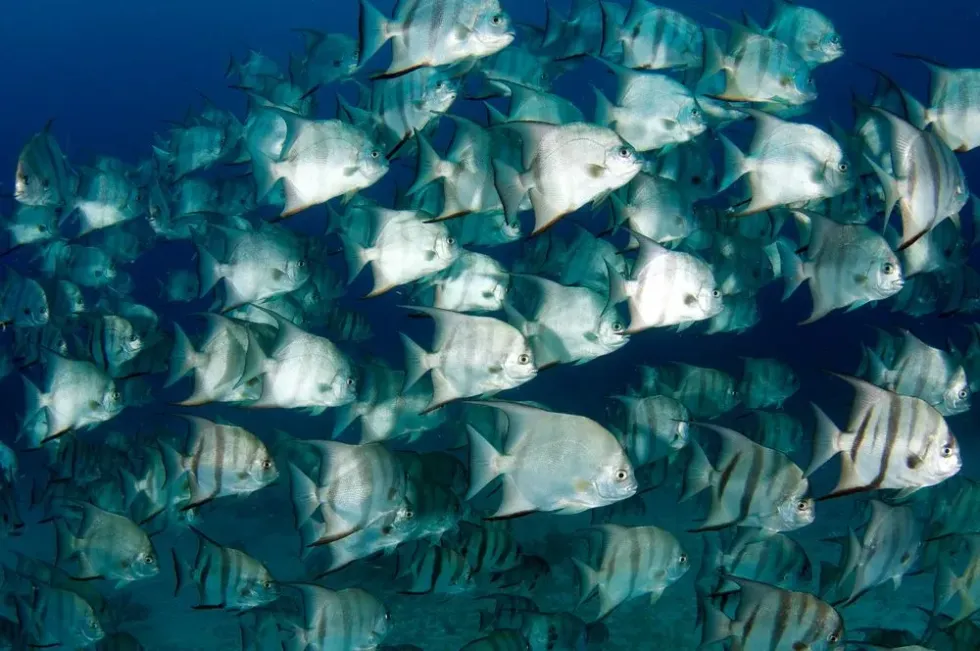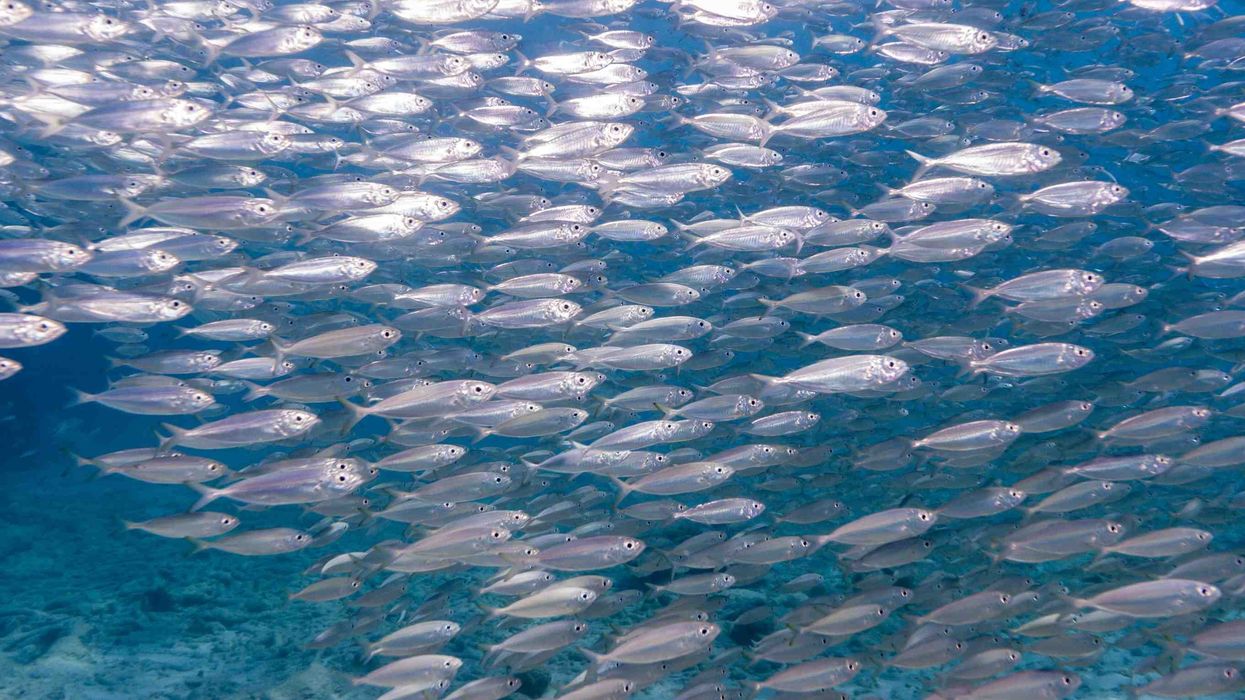The Atlantic spadefish, Chaetodipterus faber, is a dazzling fish that is a member of the Ephippidae family. It is also commonly known as the angelfish, moonfish, pot cover, sea donkey, butterflyfish, and the spadefish.
It is a silver-colored fish that has four to six black stripes on both sides of its body. These bands may fade in larger fish.
It can grow up to the length of 2.9 ft (91 cm) and weighs approximately 10 lb (4.5 kg). It is a compressed, disk-shaped marine animal that possesses a blunt mouth. It has scaled fins and a scaled head, and both of its dorsal fins are separated from each other.
This fish is caught by some anglers due to its fighting spirit. Its flesh can, however, cause ciguatera poisoning
This fish is the only fish in the Ephippidae family that dwells in the western region of the Atlantic Ocean. It can be found in the Atlantic Ocean, starting from Massachusetts in the United States, towards southeastern Brazil.
It is also found in the northern Gulf of Mexico, Bermuda, and the Caribbean. It is known to inhabit marine and brackish shallow waters of beaches, mangroves, shipwrecks, and harbors. It is typically seen in schools of as many as 500 spadefish!
The spawning season of the Atlantic spadefish is from May to September on the inner shelf of the coast of the United States. Keep reading to get to know more fun facts about the Atlantic spadefish!
If you enjoyed reading our Atlantic spadefish interesting facts, you must check out our stingray surprising facts and flagfin angel interesting facts!
Atlantic Spadefish Interesting Facts
What type of animal is an Atlantic spadefish?
The Atlantic spadefish, Chaetodipterus faber, is a species of fish.
What class of animal does an Atlantic spadefish belong to?
The Atlantic spadefish, Chaetodipterus faber, belongs to the class Actinopterygii. This fish was first described by a French naturalist, Pierre-Auguste-Marie Broussonet, in 1782 as Chaetodon faber. However, its scientific name was changed to Chaetodipterus faber in 1782.
How many Atlantic spadefish are there in the world?
The current population of the Atlantic spadefish is unknown. However, the spawning, feeding, and schooling behavior of this marine species all increase the potential for excessive fishing.
Where does an Atlantic spadefish live?
This species can be found in the Atlantic Ocean. It has a limited range, starting from Massachusetts in the United States, towards southeastern Brazil.
It is also found in the northern Gulf of Mexico, Bermuda, and the Caribbean. This fish is the only one in the Ephippidae family that dwells in the western Atlantic Ocean. No native fish that look like the Atlantic spadefish inhabit the same area as the Atlantic spadefish.
However, the Atlantic spadefish is often confused with the angelfish. Angelfish can be easily differentiated from Atlantic spadefish when looking closely at them, as they have just one dorsal fin, compared to the two dorsal fins of the Atlantic spadefish.
What is an Atlantic spadefish's habitat?
The Atlantic spadefish is a schooling fish that can be seen inhabiting marine and brackish shallow waters of beaches, mangroves, shipwrecks, and harbors. It can be seen at depths of 9.8-114.8 ft (3-35 m).
It is seen near subtropical reefs, typically off the coast of the Bahamas and Florida towards the Gulf of Mexico and southeastern Brazil. Juveniles of this species also live in shallow waters and have been observed to swim in a way that disguises them as dead leaves.
Who do Atlantic spadefish live with?
Adults of this species swim in schools comprising 500 fish. Interestingly, the orbiculate batfish has been observed to swim among schools of Atlantic spadefish!
How long does an Atlantic spadefish live?
The Atlantic spadefish, Chaetodipterus faber, has a lifespan of 8-10 years.
How do they reproduce?
The spawning season of the Atlantic spadefish starts in May and goes on until September on the inner shelf of the coast of the United States. A female Atlantic spadefish can spawn up to 1 million eggs each spawning season.
These eggs are buoyant and very tiny. They hatch after 24 hours.
The hatched eggs are called larvae, and the larvae feed upon the yolk sac for the initial two days of their life.
Their pectoral fins and caudal fins are developed 28 hours after hatching. Teeth and lateral lines start to become visible as the larvae become juveniles and three black bands can be seen as these babies reach 0.7 in (20 mm) in length.
The fourth black band can be seen when they become 1.181 in (30 mm) long and the fifth can be seen when they become 1.5-1.9 in (40-50 mm) long. Juveniles of both sexes attain maturity at the age of one.
What is their conservation status?
The Atlantic spadefish, Chaetodipterus faber, has a conservation status of Least Concern as per the IUCN's Red List.
Atlantic Spadefish Fun Facts
What do Atlantic spadefish look like?
The Atlantic spadefish can grow up to up to 2.9 ft (91 cm) and weighs between the range of 3-10 lb (1.3-4.5 kg). It is a compressed disk-shaped marine animal that possesses a blunt mouth.
It has scaled fins and a scaled head. Both of its dorsal fins are separated from each other and it is a silver-colored fish that has four to six black vertical stripes on both sides of its body.
These bands may fade in larger fish.
The margin of the caudal fin of this spadefish is concave and juveniles have dark brown or black coloration, making them resemble dead leaves. The coloration of the adult resembles that of the sheepshead, but with a shorter snout and round body, with large anal and dorsal fins.
The sheepshead's black vertical bands don't fade in the way that they do on the body of the spadefish. The Atlantic spadefish also possess brush-like teeth that are arranged in bands.

How cute are they?
These marine animals are quite cute. They have a brilliant silver body with characteristic black bands and their rounded snout is quite adorable.
How do they communicate?
It isn't known how these fish communicate with each other. However, we do know that fish commonly communicate through motion, color, bioluminescence, smell, and electrical impulses.
How big is an Atlantic spadefish?
The Atlantic spadefish can reach a length of 2.9 ft (91 cm). It is five times the size of the altum angelfish!
How fast can an Atlantic spadefish swim?
The speed of this fish has not been evaluated yet. However, we do know that they have a fighting spirit that makes it tough for anglers to catch them.
How much does an Atlantic spadefish weigh?
These fish range between 3-10 lb (1.3-4.5 kg) in weight.
What are their male and female names of the species?
There are no specific names for male and female Atlantic spadefish.
What would you call a baby Atlantic spadefish?
Babies of this species can be referred to as juveniles.
What do they eat?
These bottom-feeding fish feed upon benthic invertebrates such as marine worms, annelids, mollusks, cnidarians, and crustaceans. They have also been observed to consume plankton and nibble the tentacles of jellyfish. They feed throughout the day, mostly at midday. These fish are preyed upon by sharks like the dwarf lantern shark and large fish like the tripletail.
Are they dangerous?
These fish have caused ciguatera poisoning after consumption by humans and they accumulate toxins that are produced due to feeding upon macroalgae and corals. Thus, if the toxin levels are high in the flesh of these fish, it can cause poisoning in humans.
For this reason, they are not good to eat. Apart from this, Atlantic spadefish are quite friendly and have been observed to swim peacefully around scuba divers in circles.
Would they make a good pet?
These marine animals are often kept in large aquariums where they can be reared successfully in captivity. There are no known instances of these fish being kept as domestic pets. They reach a large size, which is why they aren't normally kept in small aquariums at homes. It is probably best to let them exist in their natural habitat.
Did you know...
This fish is endemic to the western Atlantic Ocean.
How many eggs do Atlantic spadefish lay?
The female Atlantic spadefish can spawn 1 million eggs per spawning season!
Can you keep spadefish in Florida?
Yes, an angler can keep spadefish in Florida. As per new laws, an angler is allowed to catch and keep 10 spadefish each day, or 30 spadefish per boat. They can only keep spadefish that have a total length of 14 in (35.5 cm) at least.
Here at Kidadl, we have carefully created lots of interesting family-friendly animal facts for everyone to discover! Learn more about some other fish from our salmon facts for kids and striped Raphael catfish interesting facts pages!
You can even occupy yourself at home by coloring in one of our free printable Atlantic spadefish coloring pages.










